December New Residential Single Family Home Sales decreased by -7.3%, or 369,000 annualized sales. The decline wipes out November's revised 9.3% increase. As we've repeatedly cautioned, beware of this report for most months the change in sales is inside the statistical margin of error and will be revised.
New single family home sales are now 8.8% above December 2011 levels, but this figure has a ±24.8% margin of error. A year ago new home sales were 339,000. Sales figures are annualized and represent what the yearly volume would be if just that month's rate were applied to the entire year. These figures are seasonally adjusted as well.
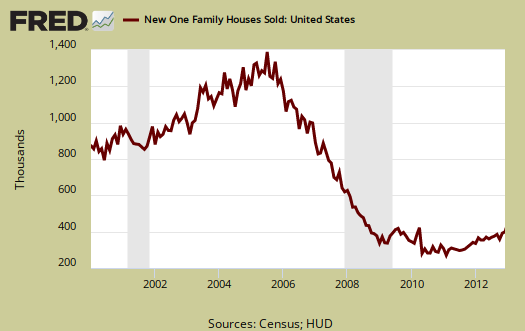
We also have an annual estimate for all new homes sold in 2012. New home sales increased 19.9% annually with a volume of 367,000 for the year. This figure is outside the ±4.8% error margin.
The average home sale price was $304,000, a 4.9% increase from last month's average price of $289,900. Most wages in America simply cannot afford these prices.

December's median price increased 1.3%, from $245,600 to $248,900. Median means half of new homes were sold below this price and both the average and median sales price for single family homes is not seasonally adjusted.
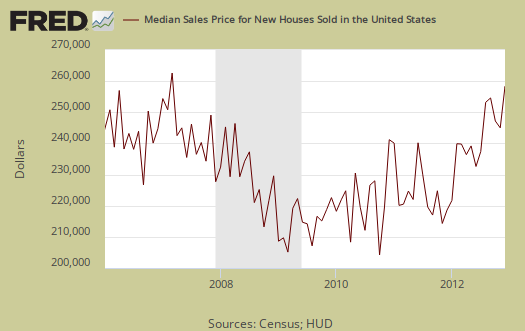
Inventories are still amazingly tight as they are in existing home sales. The current supply of new homes on the market would now take 4.9 months to sell at December's sales rates and this is a -9.3% decline from a year ago. November showed a 4.5 month time window to sell the new home.
The amount of new homes for sale was 151,000 units, annualized and seasonally adjusted, an increase of 1.3% from last month. From a year ago housing inventory has declined -0.7%, still in the margin of error of ±1.6%.
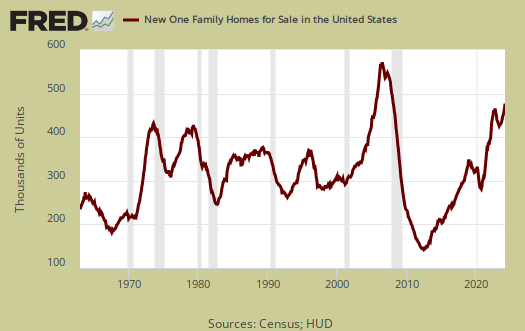
Below is a graph of the months it would take to sell the new homes on the market at each month's sales rate. We can see these inventories vs. sales times have dropped dramatically which implies demand is still low.
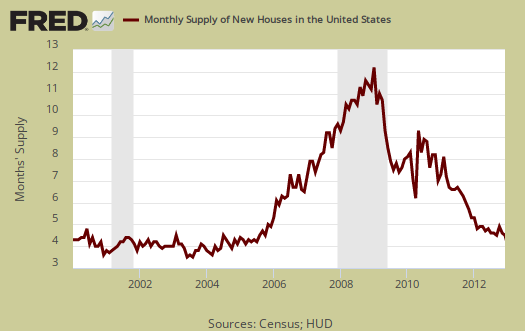
The median time a house was completed and on the market for sale to the time it sold was 4.6 months, a dramatic drop of -17.4% in comparison to November's 5.4 month median.
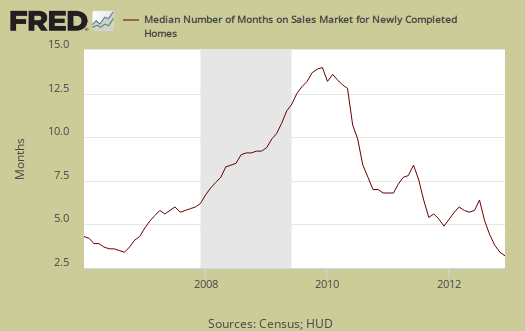
The variance in monthly housing sales statistics is so large, in part, due to the actual volume declining, along with the fact this is a survey. One needs to look at least a quarter to get a real feel for new home sales, but a year of sales data is more in order. Additionally this report, due to it's huge margin of error, is almost always revised significantly the next month. Buyer beware on month to month comparisons and reacting to primarily figures and why we graph up the statistics so one can identify a real trend versus press headline buzz.
What we know about new homes sales are increasing from the year ago change. We also see new single family home prices being out of reach for most families by income. We list the margins of error for they are usually above the monthly reported percentage changes. The Census notes that the average revision is about 5% of the original reported.

the median price chart
is deceptive because it looks like new home prices have returned to 2007 levels; however, a theoretical buyer in Dec 2007 was paying $1508 a month on a 30 year mortgage at 6.10%; this year's median buyer pays but $1096 monthly on his 30 year fixed at 3.35%...
rjs
assume one-third cash buyers
I don't have the breakdown for new homes but we need to break it down by price, whereas 30 yr. fixed is a whole other ball game.
that's a big assumption
at least for new home sales...i've always assumed that the large percentage of cash buyers of existing homes were buying mostly distressed properties below market as an investment..
rjs
cash buyers
NAR put out 2012 profile data and said for all home sales it is 40%. I found in 2011 new home sales were 38% cash from Marketwatch.
People are broke and if anyone notices volume is still low in comparison to earlier in the decade. Although your point is well taken. If one can qualify for a mortgage, the rates make things much cheaper. Rates matter.
I have to take NAR statistics with a cynical eye for the commentary contained within is always major hype. In 2010, I do not have an exact quote but it was pipe dream projections. for the future. Scary because the transactions surrounding existing home sales enter into the GDP figures. Yet because of that I will assume their transaction figures have to be accurate.